

The DNA Project by j.viewz. Helen de Cruz and Johan de Smedt, "A Natural History of Natural Theology" (MIT Press, 2015) Kocku von Stuckrad, "The Scientification of Religion: An Historical Study of Discursive Change, 1800-2000" (De Gruyter, 2014) Iain W. Provan, "Seriously Dangerous Religion: What the Old Testament Really Says and Why It Matters" (Baylor UP, 2014) Denis Dragovic, "Religion and Post-Conflict Statebuilding: Roman Catholic and Sunni Islamic Perspectives" (Palgrave Macmillan, 2015) Denis Dragovic View on Amazon The subject of statebuilding has only become a more visible issue since the end of the Cold War and collapse of the Soviet Union.
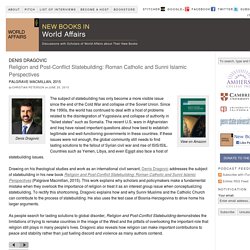
Since the 1990s, the world has continued to deal with a host of problems related to the disintegration of Yugoslavia and collapse of authority in "failed states" such as Somalia. The recent U.S. wars in Afghanistan and Iraq have raised important questions about how best to establish legitimate and well-functioning governments in these countries. If these issues were not enough, the global community still needs to find lasting solutions to the fallout of Syrian civil war and rise of ISIS/ISIL. Drawing on his theological studies and work as an international civil servant, Denis Dragovic addresses the subject of statebuilding in his new book Religion and Post-Conflict Statebuilding: Roman Catholic and Sunni Islamic Perspectives (Palgrave Macmillan, 2015). Tremper Longman III, "Psalms: An Introduction and Commentary" (IVP Academic, 2014) Tremper Longman III View on Amazon The Psalms have given voice to the prayers and petitions of generations of Jews and Christians alike.
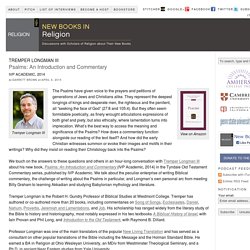
They represent the deepest longings of kings and desperate men, the righteous and the penitent, all “seeking the face of God” (27:8 and 105:4). Claire Virginia Eby, "Until Choice Do Us Part: Marriage Reform in the Progressive Era" (U of Chicago Press, 2014) Simon A. Wood and David H. Watt, eds., "Fundamentalism: Perspectives on a Contested History" (U of South Carolina Press, 2014) Winnifred F. Sullivan, "A Ministry of Presence: Chaplaincy, Spiritual Care and the Law" (University of Chicago Press, 2014) Winnifred F.
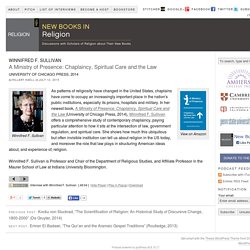
Sullivan View on Amazon. Ya'll gon learn today. Shulem Deen, "All Who Go Do Not Return: A Memoir" (Graywolf Press, 2015) Shulem Deen View on Amazon At fourteen, young Shulem Deen, a Hassid in Boro Park, New York, lost his loving father.
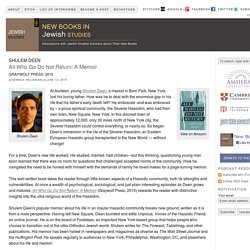
How was he to deal with the enormous gap in his life that his father's early death left? Research finds practicing retrieval is best tool for learning. Research findings by Jeffrey D.
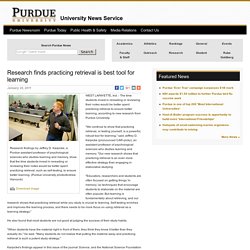
Karpicke, a Purdue assistant professor of psychological sciences who studies learning and memory, show that the time students invest in rereading or reviewing their notes would be better spent practicing retrieval, such as self-testing, to ensure better learning. (Purdue University photo/Andrew Hancock) Download image WEST LAFAYETTE, Ind. - The time students invest in rereading or reviewing their notes would be better spent practicing retrieval to ensure better learning, according to new research from Purdue University. "We continue to show that practicing retrieval, or testing yourself, is a powerful, robust tool for learning," said Jeffrey D.
"Educators, researchers and students are often focused on getting things 'in memory,' so techniques that encourage students to elaborate on the material are often popular. The concept of different “learning styles” is one of the greatest neuroscience myths. Are you a visual learner who writes notes in a rainbow of different colors, or do you have to read something aloud before it will sink it?
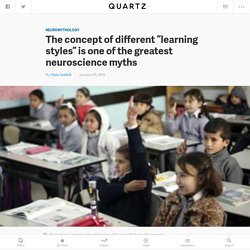
Chances are, you’ve been asked a similar question at some point in your life, and believe the concept of different “learning styles” is perfectly valid. But, as Quartz reported in December, we all learn in fundamentally similar ways. And, as New York magazine reports, the idea that students learn differently depending on their personal preference for visual, auditory or kinesthetic cues is just a myth.
My Writing Education: A Time Line. February 1986 Tobias Wolff calls my parents’ house in Amarillo, Texas, leaves a message: I’ve been admitted to the Syracuse Creative Writing Program.
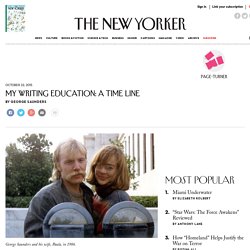
I call back, holding Back in the World in my hands. For what seems, in chagrined memory, like eighteen hours, I tell him all of my ideas about Art and list all the things that have been holding me back artistic-development-wise and possibly (God! Yikes!) Ask if he ever listens to music while he writes. The High School Where Poetry Covers the Walls. Where does musical genius come from?
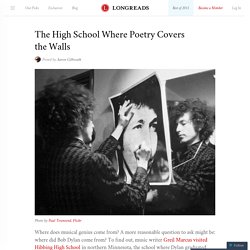
A more reasonable question to ask might be: where did Bob Dylan come from? To find out, music writer Greil Marcus visited Hibbing High School in northern Minnesota, the school where Dylan graduated, and whose legend centers around the school’s striking architecture, lavish decoration and creative influence. Originally printed in 2007 in the journal Daedalus, Marcus’ essay appears in his book Bob Dylan by Greil Marcus: Writings 1968-2010. In the Dark and the Gloom: Alvin Schwartz’s Scary Stories to Tell in the Dark. First published in 1981, Alvin Schwartz’s Scary Stories to Tell in the Dark and its two sequels have become a famed rite of passage for many young readers.
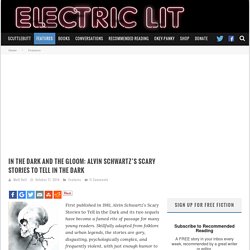
Skillfully adapted from folklore and urban legends, the stories are gory, disgusting, psychologically complex, and frequently violent, with just enough humor to keep you turning the pages even after you knew reading just one more meant a nightmare or sleeplessness. As skillful as Schwartz’s writing is, the books were also famous for Stephen Gammell’s haunting illustrations which accompanied each story. Together, the writer and the artist created one of the most enduring and memorable works of children’s literature published in our lifetime.
Anne Valente and I first met in the MFA program at Bowling Green State University. Making Candy Canes in Denver for More Than 90 Years. How the Nazis stole Christmas. In 1921, in a Munich beer hall, newly appointed Nazi party leader Adolf Hitler gave a Christmas speech to an excited crowd.

According to undercover police observers, 4,000 supporters cheered when Hitler condemned “the cowardly Jews for breaking the world-liberator on the cross” and swore “not to rest until the Jews…lay shattered on the ground.” Later, the crowd sang holiday carols and nationalist hymns around a Christmas tree. Working-class attendees received charitable gifts. For Germans in the 1920s and 1930s, this combination of familiar holiday observance, nationalist propaganda and anti-Semitism was hardly unusual.
As the Nazi party grew in size and scope—and eventually then took power in 1933—committed propagandists worked to further “Nazify” Christmas. Given state control of public life, it’s not surprising that Nazi officials were successful in promoting and propagating their version of Christmas through repeated radio broadcasts and news articles. Redefining Christmas. A Very Merry History of the Santa Suit. It’s something of a habit among liberal Americans to talk about how excellent the Netherlands are.
They have socialized healthcare, strict gun control laws, beautiful furniture, a ton of bicycles, and apparently… they also gave birth to Santa Claus. Or, at least, the earliest version of Santa Claus as we know him today. He’s based on Saint Nicholas, a bishop who supposedly lived around the fourth century. Saint Nicholas was famous for leaving coins in poor children’s shoes or stockings, and, in one case, bestowing a dowry on three poor women from a Christian family so they wouldn’t have to become prostitutes. The prostitution part of the story that doesn't make it into "A Visit from St.
Image: Transcendental Graphics/Getty. Can computers be racist? Big data, inequality, and discrimination. Pulling the Thread of Unsafe Spaces: Part 1. This is the first post in a two-part series. Creative Commons-licensed image by David Swayze "Be your entire self at work. " You might hear these words during orientation at a new job, if you work for the kind of company that prides itself on its open, informal culture -- a software company in Silicon Valley, perhaps. When you hear that everybody is free to be their entire self at your workplace, do you hear a promise or a threat? "You're allowed to bring your whole self to work" should be true by default; in an ideal world, it wouldn't need to be said.
Here's another thing you might hear tech people say that's so vague as to be tautological: "We don't need a code of conduct, because all we need to do is be excellent to each other or say 'don't be a dick.'" My “Theory” of Codes of Conduct. Yes, the COCs we see are generally neutral. And yes [sic] the discussions have this gender biased focus. Because harassment is a gendered phenomenon. There’s no “and yet.” If you’re talking about harassment you must talk about gender. Somehow. Yet what happens when men try to bring up and solve the problem? What 200 Years of African-American Cookbooks Reveal About How We Stereotype Food. BOOK EXCERPT: First African-American NYPD officer's journey - NY Daily News. Samuel (Jesse) Battle was a pioneer of black America — the first African American to join the police department in greater New York City. In the upcoming book “One Righteous Man: Samuel Battle and the Shattering of the Color Line in New York,” author Arthur Browne traces Battle’s amazing journey — from his childhood in North Carolina, to his days as a railway porter at Grand Central Station and a 30-year police career starting in 1911 that saw him become the city’s first African American police sergeant and then lieutenant.
The following excerpt describes the first days of Battle’s life on the job: His son Jesse slept in the shadows of the small apartment while his wife Florence prepared breakfast. The air of a summer of rains and high heat was heavy, even this early. Sam Battle got “tubbed and scrubbed,” and then he put on the uniform that designated authority to enforce the law. Samuel (Jesse) Battle the first African American to join the police department in greater New York City. 'The Jemima Code,' Two Centuries of African-American Chefs. The University of Texas Press Austin food writer Toni Tipton-Martin’s compilation of African-American cookbooks opens with this line from American historian Gaillard Hunt: “The professional cooks of the country were Negroes and the national cookery came from them.” Bitter Herbs And Collard Greens: An African-American Seder Plate For Passover : Code Switch.
Mariana Candido, "An African Slaving Port and the Atlantic World" (Cambridge UP, 2013) Kirt von Daacke, "Freedom Has a Face: Race, Identity, and Community in Jefferson's Virginia" (UVA Press, 2012) Bruce Laurie, "Rebels in Paradise: Sketches of Northampton Abolitionists" (UMass Press, 2015) Bruce Laurie View on Amazon. Ted A. Smith, "Weird John Brown: Divine Violence and the Limits of Ethics" (Stanford UP, 2014) Roberts Downing Af Am JSTOR. Passing Through. The tenant in the ground-floor apartment at 315 Second Avenue lived alone. A Rust Belt Story Retold, Through Portraits Of The Women Who Lived It : Code Switch. Capturing blues in black and white. Tim Duffy has spent decades photographing blues musicians who work with his nonprofit, the Music Maker Relief Foundation. Earl Lloyd Was Basketball's Jackie Robinson. Why Isn't He Famous? : Code Switch. Fort Wayne's Mel Hutchins (9) and Syracuse's Earl Lloyd (11) reach for the ball during an NBA basketball game in Indianapolis in 1955.
AP hide caption itoggle caption AP Fort Wayne's Mel Hutchins (9) and Syracuse's Earl Lloyd (11) reach for the ball during an NBA basketball game in Indianapolis in 1955. I'm From Philly. 30 Years Later, I'm Still Trying To Make Sense Of The MOVE Bombing : Code Switch. Boarded-up homes on Osage Avenue in Philadelphia. Thirty years ago this street was bombed in a standoff between MOVE and the Philadelphia police. April Saul for NPR hide caption itoggle caption April Saul for NPR. 'Chi-Raq' Scratches At Black America's Generation Gap In A Time Of Protest. Does Cleveland Know the Secret to Building Wealth Without Gentrification? The following is an excerpt from City by City: Dispatches from the American Metropolis, a collection of essays on American cities, written by the people who live in them.
Andrew Hartman, "The War for the Soul of America: A History of the Culture Wars" (U of Chicago Press, 2015) Lessons of the Arkansas. Institutions and Imaginaries, Smith. The Man Who Saw America. The Trace - A new source of reporting and insight about guns in America. - The Trace. How to Stop Mass Shootings - Why Mass Shootings Keep Happening. Misophonia: Noises That Ruin Your Life. South Korea Continued.
Steven E. Kemper, "Rescued from the Nation: Anagarika Dharmapala and the Buddhist World" (U of Chicago Press, 2015) The story of Sinbad or the seven sages. The Life of the Buddha in Thai manuscript art. Ceremonials.